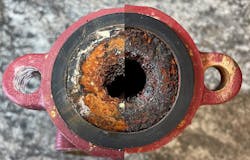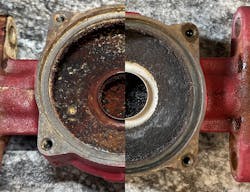Water Treatment Testing: Instructions v. Reality
By BRAD ALLEN, Sr. Technical Services Manager, Pace Solutions
Testing a piece of old fouled equipment in a lab environment to prove the efficacy of a water treatment additive is a rare opportunity. System cleaning products generally come with instructions, dilution standards, and recommendations. It’s easy for a water treatment technician to take the directions at face value, perhaps keeping an eye on results in the field to ensure that products are performing as instructed.
However, sometimes, circumstances allow a little time to test theories. That was the case not long ago for Patrick Denis, a Technical Representative for Pace Solutions on the Regina, Saskatchewan team.
“Covid protocols shuffled around our workstations, and I found my new office in the lab, which turned out to be a learning experience,” Denis explained. “I was watching the lab activity going on, testing for legionella, water composition, etc., and I suddenly realized that I had an experiment right there on my desk, waiting to happen.”
A customer had left a clogged pump body, which sat on his desk, holding down files. Heavy and somewhat unsightly, the item was also the subject of a request. The customer who brought it in had also left behind two questions:
- What had caused the clog? and...
- What could prevent that clog from happening again in the future?
As a water treatment professional, Denis thought he knew the answers. But for his own curiosity and education, he decided to test his advice before conveying it back to the customer.
Testing for Cause
Denis was the only one in the office on a late autumn afternoon when one of the plumbers from a local farming company stopped by. The company operates buildings that utilize boiler heating systems, a couple of which are serviced regularly by Pace. The farming company maintenance crew does the majority of the water treatment on the remaining buildings but sometimes they look to Pace Solutions for advice.
This was the case when the plumber brought in the pump body with three openings and a solid mass throughout the T-junction. This severe clogging caused the pump to seize, leading to the closed-loop boiler heating system to stop heating. The customer said that he had already replaced the body, but asked if Pace would investigate what had caused the seizure, and then offer advice.
A closer examination revealed that the component was part of a boiler pump with an output of about 15 GPM at 12 PSI. The 2-in-wide pipe in the body was completely clogged with corrosive scale, indicating years, perhaps even a decade of buildup. Denis suspected from the color that the scale was mostly copper. While the customer was present, he sprinkled some copper reagent powder on it and a few drops of reverse osmosis (RO) water. The RO droplet turned purple indicating high levels of copper.
“When I asked him about the current system care he revealed that the system had never been tested or flushed,” Denis said. “I suggested some care solutions, but it involved a flush. Since winter heating season was upon us, (the customer) decided against any new treatment solution until spring, and left without the old pump body. So, there it sat on my desk.”
Later, Denis imagined what the internal piping of the rest of the system might look like. He wondered how long the new pump would last due to the lack of treatment and the increased burden on the mechanics. This piqued his curiosity to see if the solution he had offered would have been adequate against such an intense buildup.
Water Treatment Experimentation
Last winter, finding himself some time, he decided to conduct an experiment. Running water through the pump body, Denis found that no water would pass through. Amazed, he could not recall any other time that he had ever experienced a situation where there was not at least a pinhole for water to pass through.
The product that he’d recommended to the customer and decided to experiment with was a concentrated alkaline liquid purging detergent that cleans closed-loop hot water heating and chilled water systems prior to the introduction of a corrosion inhibitor treatment or glycol.
A treatment like this would be run through the system, loosening the adhered scale, layer by layer, sequestering it into the make-up water, and releasing it with the outflow when the system is flushed. The stabilization of the ferrous metal surfaces using an alkaline detergent (with included inhibitor) offers short term protection prior to the addition of the primary inhibitor to minimize the potential for flash corrosion. Without releasing adhered scale from the internal pipe surface, corrosion inhibitors are rendered ineffective since they’re designed to coat and protect pipe surfaces from the effects of oxidization and other causes of corrosion.
Consulting with colleagues, Denis received similar recommendations for testing the product:
- Add to the system a rate of 1-part treatment to 100 parts water;
- Provide circulation for at least 24-48 hours throughout the entire system;
- Provide a running flush of the system until the pH & TDS levels in the test water are the same as the make-up water.
The instructions restricted the concentration to 4% to avoid damage to the system or its components. The 48-hour period is important because it means the cleaning cycle and flush can happen over a weekend when most commercial facilities and buildings that rely on boiler systems for heat are likely not occupied.
The experiment was conducted in two parts:
Experiment #1 – In a bucket, Denis poured 1 gallon of water and doused it with 1% alkaline purging detergent (approximately 37 ml). He inserted a small pump with an output of 15 strokes per minute to agitate the water. This step is important to help the water circulate over the surface of the scale and pull away from the surface as it sheds. Without this step, the substance would not penetrate beyond the first layer of the hydrophobic material.
Experiment #2 – The second experiment added more water, 3 gallons, with a 4% concentration (approx. 450 ml). He left it for 8 hours with the same small pump set at 90 strokes per minute. Denis found that the higher concentration cleaned a significant amount of scale compared to the 1% concentration.
The alkaline detergent cleared the scale down to the pipe surface, creating the optimum environment for corrosion inhibitors to work effectively. With the proper cleaning, this pump body could potentially have been put back into service. Moreover, the pH & TDS levels of the flushed water matched that of the make-up water.
Conclusion
Denis showed the experiment images and results to colleagues and listened to their professional opinions. He concluded that he would have treated the system with a 1% - 1.5% concentration for 48 hours. The reason for using the lower concentration is the pressure. The 1% concentration showed that large pieces did come off and the higher pressure would aid in stripping layers that the low PSI pump would not necessarily assist with, allowing the detergent to treat the layers and effectively reach the pipe wall.
“This cleaner has effective and aggressive characteristics, so higher concentrations may erode the inner walls of the pipe and increase the chance of corrosive pitting or bursting due to thinning walls under high pressure,” Denis observed. “What this taught me is that, as tempting as higher concentrations might be, it may not always be the best for the system. This is about system health, efficiency, and longevity. More time at lower concentrations is better than less time at higher concentrations, even if it means that the cleaner needs to run for longer.”
He added, if this service is done as needed (determined by regular water testing), then the cleaning and flush cycle should be much shorter and less invasive.
# # # #
Based in Delta, British Columbia, Pace Solutions is a water treatment company that works with a wide variety of industries from facility management to horticulture, providing solutions for developers, plant operators, manufacturers, and growers to meet or exceed environmental sustainability and energy reduction goals. For more, visit www.pacesolutions.com.




